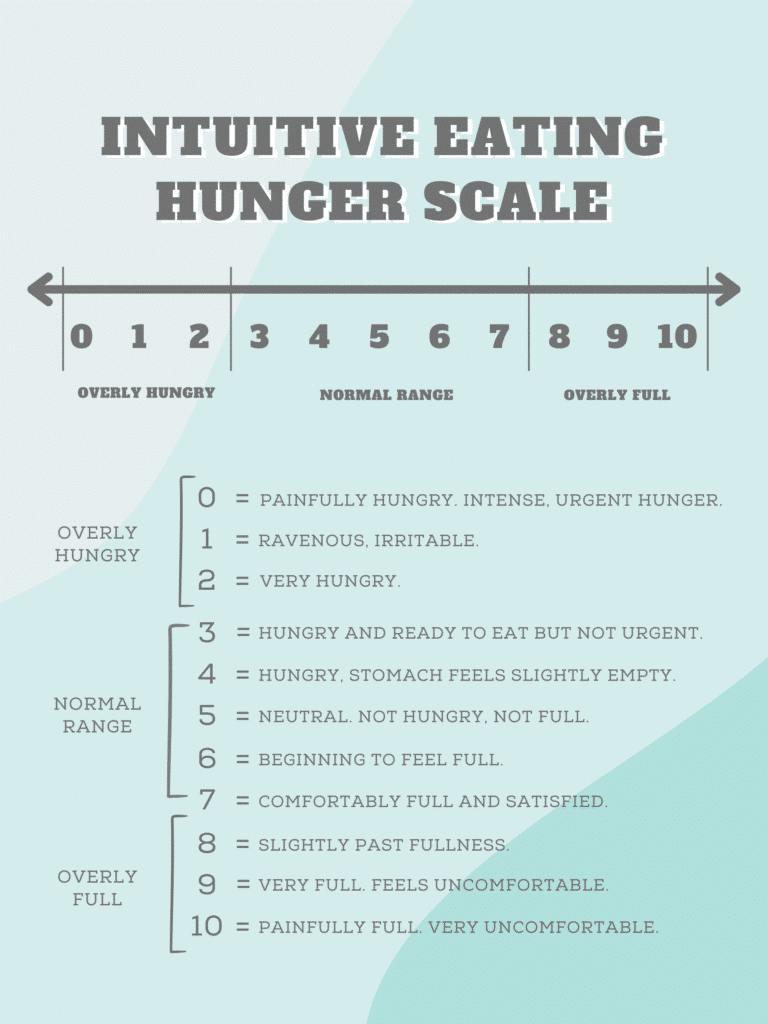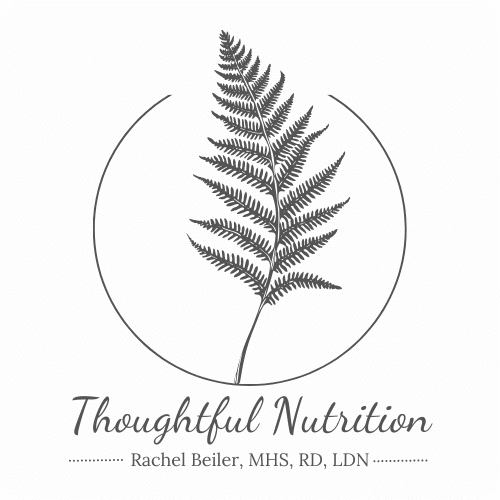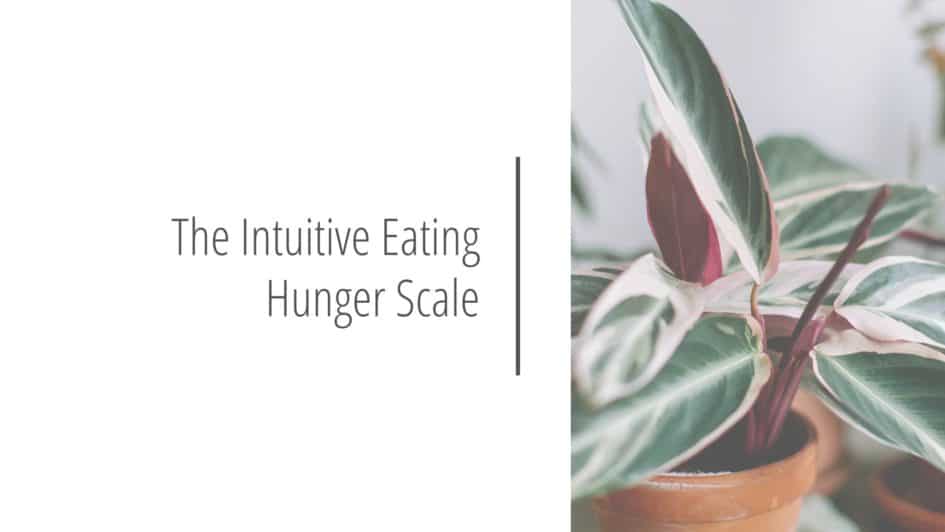Table of Contents
What is the Intuitive Eating Hunger Scale?
The Intuitive Eating hunger scale is a tool that can be used when practicing Intuitive Eating (IE). It is used to assess your level of hunger versus your level of fullness.
The scale ranges from 0-10 with 0-2 being overly hungry, 3-7 being the normal range of hunger, satisfaction, & fullness, and 8-10 being overly full.
This can be used as a guide when first starting your Intuitive Eating journey or even as a nice reminder when you are a seasoned intuitive eater.
Using this scale can help guide us through multiple Intuitive Eating principles but especially Principle #2, Honor Your Hunger as well as Principle #6, Feel Your Fullness. Keep reading to learn how to apply the scale to these 2 principles!
The scale is available for PDF download at the end of this article.

Intuitive Eating – Principle 2: Honor Your Hunger
According to Intuitive Eating – A Revolutionary Anti-Diet Approach, 5th Edition, the first step in honoring hunger is to learn how to identify it.
To read an in-depth explanation of Honor Your Hunger – Intuitive Eating Principle 2, check out this article.
Identifying Hunger
Common signs of hunger, ranging from mild hunger to ravenous hunger include feeling mild stomach gurgles, hearing growl-like noises from the abdominal area, feeling lightheaded or faint, experiencing difficulty concentrating, feeling uncomfortable stomach pains, mood shifting to something such as irritability, and even experiencing a headache.
Not everyone can physically feel hunger. This could be due to dieting, trauma history, numbing, or stress amongst many other things. If gauging hunger is difficult for you, a generally good rule of thumb is to go no longer than 5 daytime hours without eating. This timing is based on the carbohydrate storage that’s available in the liver, which needs to be replenished every 3-6 hours, as it runs out of resources.
Be patient with yourself. In time you will learn how to identify and honor your hunger.
Avoiding Ravenousness
A very important aspect of Honoring Your Hunger is being vigilant in not getting overly hungry or ravenous. This is a great area to use the hunger scale. If you glance at the scale, being overly hungry is 0-2, with 0 being the most extreme level of hunger. This ranges from painful, urgent hunger to ravenous, irritable hunger, to very hungry.
Within the Intuitive Eating framework, it’s important to not let hunger get to this stage. According to the scale, hunger should feel like you’re ready to eat, but not in an urgent manner (rated as 3). It should not be more intense than a stomach that feels slightly empty (rated as 4).
We can’t possibly honor our hunger OR our bodies when we let ourselves get to this ravenous, urgent state.
Types of Hunger
Another important factor to consider is the different types of hunger.
- Physical hunger: the type of hunger we have been discussing; aka biological hunger
- Taste hunger: wanting to eat simply because something sounds good
- Practical hunger: also known as planning ahead hunger; this is where you might eat before you physically feel hungry because you know you won’t have the opportunity to eat when you actually become hungry: an example would be eating an early lunch because you have a work meeting over your typical lunch period
- Emotional hunger: hunger used to satisfy uncomfortable feelings such as loneliness, guilt, despair, boredom, anger, etc.
All forms of hunger should be honored, not just physical hunger. Recognizing the different forms of hunger allows us to avoid setting rigid rules around eating only when we are physically hungry. Doing this helps keep us from slipping back into the diet mentality of restriction. It will take time to find this balance!
Side note: IE Principle #7, Cope with Your Emotions with Kindness, discusses the importance of developing coping mechanisms that do not revolve around food. This addresses emotional hunger in greater detail. For more information on Principle #7, visit the official Intuitive Eating website for resources.
Hunger Looks Different
It’s important to note that everybody experiences hunger on different levels, in different ways. To get in touch with your body and what hunger feels like for you, check in with yourself on a regular basis throughout the day.
This is where the scale can be applied to help you practice Principle #2! Doing this allows you to slowly become the master of honoring your hunger.
Intuitive Eating – Principle 6: Feel Your Fullness
“In order to honor your fullness, you need to trust that you will give yourself the foods that you desire. Listen for the body signals that tell you that you are no longer hungry and observe the signs that show that you’re comfortably full. Pause in the middle of eating and ask yourself how the food tastes, and what your current hunger level is.”
– Intuitive Eating – A Revolutionary Anti-Diet Approach, 5th Edition
Identifying Fullness
Similarly to how not everyone can recognize hunger, not everyone is in tune with how fullness feels. Reasons for this include chronic dieting, food insecurity, an empty plate or no waste mindset (i.e. feeling the need to always finish the plate), regularly eating in a ravenous state, and other circumstances.
According to Intuitive Eating – A Revolutionary Anti-Diet Approach, 5th Edition, fullness can be described as a substantive feeling of stomach contentedness, feeling satisfied, and pleasant completeness.
The sensation of being full is different for everyone. It is highly individualized. Trying to explain how fullness feels to someone is like explaining how snow feels. We can try our best to describe the feeling but it’s something that has to be experienced at a personal level, not just explained.
The Key to Feeling Your Fullness
It’s not possible to respect your fullness if you don’t first allow yourself unconditional permission to eat.
This concept is discussed in detail with IE Principle #3: Make Peace with Food. For an in-depth discussion of this principle, head to the official Intuitive Eating website for resources.
The main takeaway from Principle #3 is that restricting yourself of certain foods can lead to an unhealthy relationship with those foods. This can lead to uncontrollable cravings and binge eating, which often results in guilt and remorse. Making peace with food and allowing unconditional permission to eat helps to diminish the control food has over your life.
With this unconditional permission, it’s easier to stop eating when fullness arises. This is because once you allow yourself to eat all foods, you don’t have the same drive or urge to eat those foods beyond fullness, because you know you can eat those foods whenever you want.
The unconditional permission helps alleviate the last supper mentality, which is the feeling that you have to ravenously consume off-limit foods because you don’t know when you will eat that restricted food again.
If this unconditional permission is not practiced, it’s not possible to fully feel or respect fullness.
Conscious-Awareness Eating
In order to feel fullness, you have to be aware and conscious during the eating process. This is a great area to apply the Intuitive Eating Hunger Scale!
When eating a meal, pause and check in with your body. On the scale, where are you? Do you still feel hunger? Are you starting to feel fullness?
Referencing the hunger scale, the normal range of fullness is from 6 to 7. A rating of 6 is beginning to feel full. A rating of 7 is feeling comfortably full and satisfied.
Notice how 7 refers to fullness and satisfaction. It’s important for the stomach to feel full as well as the mind to be satisfied after a meal. In other words, did the meal satisfy your hunger and your cravings?
The best way to be aware and conscious while eating is to eat without distraction. This often looks like eating without your phone, watching TV, or working. Purposively take the time to eat and only eat. This will help you become more in tune with your fullness cues.
Avoiding Overly Fullness
Just as we should avoid ravenousness, we should also avoid being overly full. Referencing the hunger scale, overly full can range from 8 to 10, with 8 being slightly past fullness, 9 being very full, uncomfortably full, and 10 being painfully full, very uncomfortably full.
This is not meant to be restrictive or controlling of food intake. Instead, this is meant to help us listen to our bodies and prevent overeating, which can often lead to guilt and compensatory behaviors.
Factors that Influence Fullness
Fullness is multifactorial and these factors should be considered when learning how to feel your fullness.
- Initial hunger level: starting a meal in a famished state is more likely to end in an override of fullness cues
- Type of food consumed: The macronutrient distribution (carb, fat, protein) and fiber intake will factor into how quickly a meal leads to fullness
- Social influence: eating with other people influences the amount of food consumed
- Amount of time between meals or snacks: beginning a meal with an empty stomach versus a less empty stomach will factor into how quickly fullness approaches
Fullness Looks Different
Just like with hunger, it’s important to note that everybody experiences fullness on different levels, in different ways. To get in touch with your body and what hunger feels like for you, check in with yourself on a regular basis throughout your meals.
This is where the scale can be applied to help you practice Principle #6! Doing this allows you to slowly become the master of feeling your fullness.
Download the Intuitive Eating Hunger Scale
Quick Summary of the Intuitive Eating Hunger Scale
Holistic, Anti-Diet Approach
Although there are principles to follow, you cannot fail at Intuitive Eating. The principles of Intuitive Eating are not a checklist of right or wrong. It’s not a black-or-white approach. There is nuance.
The Intuitive Eating Hunger Scale is only meant to be a tool. Not a one-size-fits-all answer to everything. Don’t let it completely dictate your hunger and fullness cues.
Please do not fall into the diet culture trap and treat Intuitive Eating like it’s just another diet. It is an anti-diet approach to health, not a diet. It helps guides you to a healthy relationship with food, mind, and body. It emphasizes a holistic approach where you become the expert of you. It’s not meant to be restrictive or controlling.
If applied properly, Intuitive Eating is literally life-changing to those who spent years drowning in diet culture.
Dig Deeper
If you would like to dig deeper into the principles of Intuitive Eating that were mentioned in this article, I recommend grabbing a copy of Intuitive Eating – A Revolutionary Anti-Diet Approach, 5th Edition by Evelyn Tribole and Elyse Resch. It can be found where books are sold, including Amazon. The official Intuitive Eating Website is also a great resource.
For additional reading, check out the Intuitive Eating section on my website. Whether you’re a newbie intuitive eater or a seasoned one, take a look at my anti-diet themed store for fun Intuitive Eating products!
Thanks for reading!
Rachel Beiler, MHS, RD, LDN
References
Intuitive Eating: A Revolutionary Anti-Diet Approach, 5th Edition by Evelyn Tribole & Elyse Resch


January 14, 2023 at 4:11 pm
Hi Rachel, This was such a helpful article. Helped me sort out how I can keep from overeating. I’ve been much more conscious of my eating habits lately and my Dr. has given me some advice in this area also, so I’ve been working on a number of things and experiencing some success. Thanks for keeping us informed on good eating habits. Love you, GMa.
March 16, 2023 at 12:03 pm
So glad you found this article helpful!